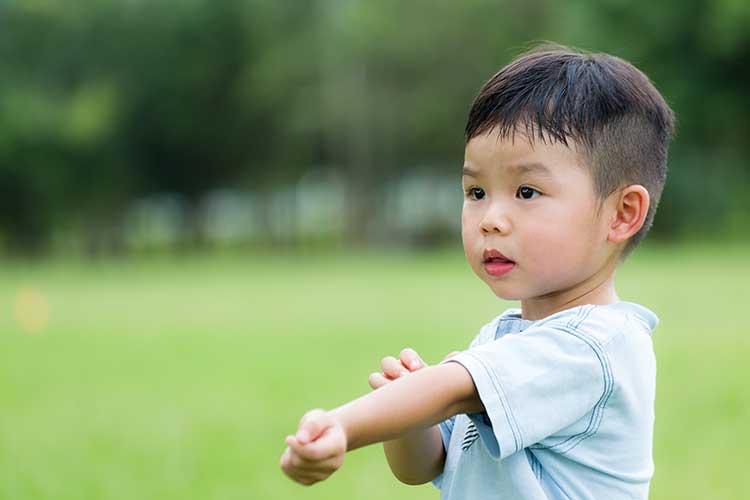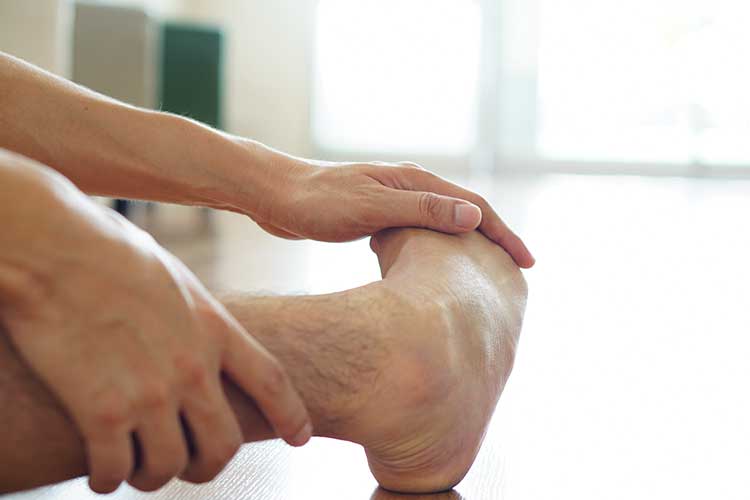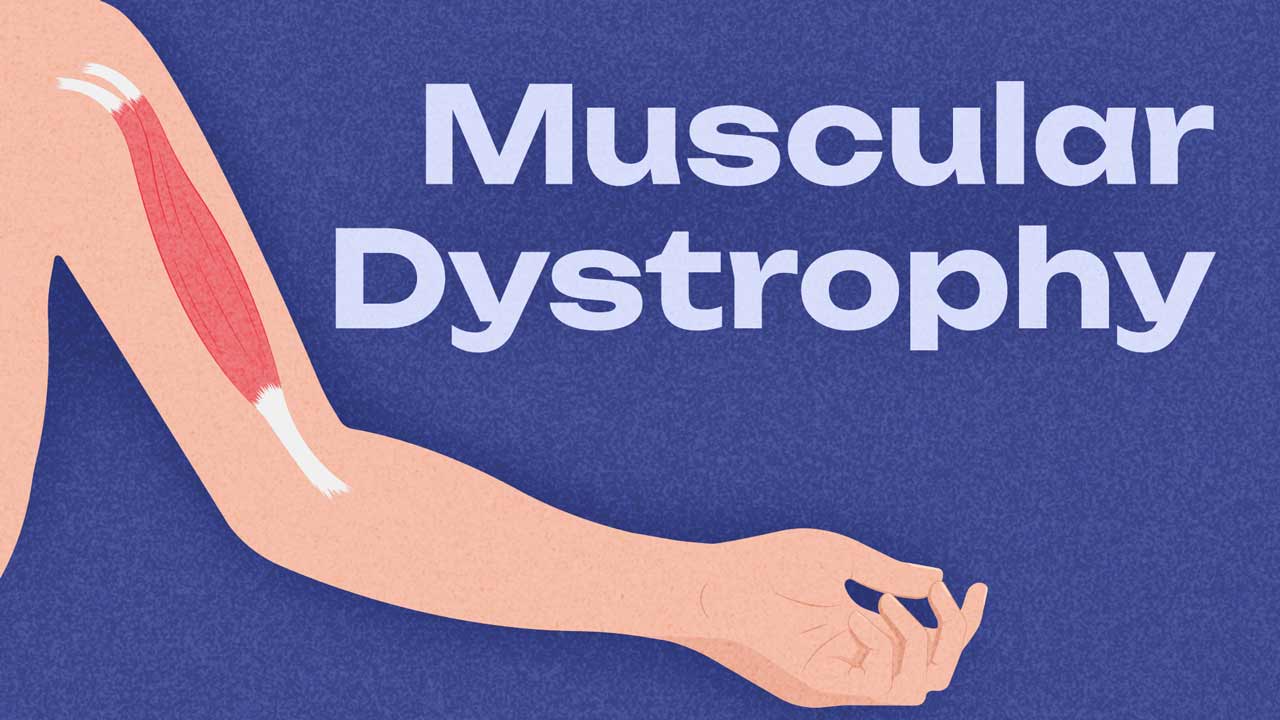What is Muscular Dystrophy?
Muscular dystrophy (MD) is an umbrella term for a group of over 30 genetic conditions that cause progressive, irreversible muscle weakness and wasting (NINDS 2024; Better Health Channel 2022).
MD is part of a wider group of over 75 neuromuscular conditions (NMCs) (Muscular Dystrophy Foundation Australia 2023) - disorders that impair the functioning of nerves that control the voluntary muscles (e.g. muscles in the arms and legs) (Cedars-Sinai 2024).
What Causes Muscular Dystrophy?
Muscular dystrophies are caused by mutations affecting various genes that code the proteins responsible for the structure and function of the muscles, making them weaker, fragile and susceptible to damage. This leads to progressive disability (NHS 2021; myDr 2024).
The type of MD that an individual has depends on the specific gene mutation that has occurred (Better Health Channel 2022).
Different types of MD also have different inheritance patterns, including:
- Autosomal dominant, where the mutated gene only needs to be inherited from one parent in order to cause MD.
- Autosomal recessive, where the mutated gene needs to be inherited from both parents in order to cause MD, and those who inherit only one copy become carriers.
- X-linked recessive, where the mutation affects a gene in the X chromosome. As males have only one X chromosome (and one Y chromosome), those who inherit the mutated X chromosome will generally be affected by MD. However, females who inherit one mutated X chromosome usually only become carriers (because they have another X chromosome that will compensate for the mutation). For this reason, X-linked recessive conditions are much more common in men.
(NHS 2021; Muscular Dystrophy UK 2024)
Sometimes, genes undergo a non-inherited, spontaneous (‘de novo’) mutation for no apparent reason (usually during the early development of the embryo). An individual who undergoes a de novo gene mutation can develop MD even if they have no family history of the disorder (Better Health Channel 2022; NHS 2021).
Types of Muscular Dystrophy
Muscular dystrophies vary in severity and can affect different muscles (Better Health Channel 2022).
There are eight main types of muscular dystrophy that will be discussed in this article.
Duchenne Muscular Dystrophy (DMD)

Inheritance pattern: X-linked recessive
Affected gene: The DMD gene, which is responsible for coding the protein dystrophin. Dystrophin maintains the structure of muscle cells and protects the muscles from damage when they contract. People with DMD produce almost no functional dystrophin.
DMD primarily affects males, and the average age of symptom onset is two to three years. Initially, DMD affects the proximal muscles (shoulders, upper arms, hips and thighs). Over time, the distal muscles near the extremities will also be affected, leading to progressive weakness and scoliosis. This may eventually lead to acute respiratory failure.
Symptoms include:
- Starting to walk later than expected
- Falling often
- Having difficulty getting up from the ground, climbing stairs and walking up hills
- Having difficulty running and jumping
- Having well-developed or large calf muscles, but other muscles that are poorly developed
- Waddling
- Lordosis (exaggerated spinal curve)
- ‘Toe-walking.’
DMD is severe and may cause complications such as:
- Restricted joint motion
- Scoliosis
- Breathing difficulties
- Heart issues
- Intellectual disability
- Reliance on mobility aids
- Premature death.
(Better Health Channel 2022; MDA 2025a)
Becker Muscular Dystrophy (BMD)
Inheritance pattern: X-linked recessive
Affected gene: DMD gene. People with BMD generally produce shortened, partially functional dystrophin.
BMD is similar to DMD and is inherited in the same way, however, BMD is less severe. The age of symptom onset ranges from 5 to 60 years. Symptoms are similar to those of DMD but slower and milder. BMB tends to have a less predictable disease progression.
(Better Health Channel 2022; MDA 2024)
Congenital Muscular Dystrophies (BMD)
Inheritance pattern: Autosomal recessive (typically)
Affected gene: Depends on the type of CMD
CMD is an umbrella term describing a range of muscular dystrophies present at or soon after birth. CMDs vary in severity and progression. They include:
- Bethlem CMD
- Fukuyama CMD
- Muscle-eye-brain diseases (MEBs)
- Rigid spine syndromes
- Ullrich CMD
- Walker-Warburg syndromes (WWS).
Infants with CMD may display symptoms such as:
- Low muscle tone
- Floppiness
- Reduced movement
- Tightness in the ankles, hips, knees and elbows (contractures)
- Breathing difficulties
- Feeding difficulties.
(Muscular Dystrophy UK 2024; Better Health Channel 2022; MDA 2021a)
Limb-girdle Muscular Dystrophies (LGMD)
Inheritance pattern:
- Autosomal dominant (LGMD1)
- Autosomal recessive (LGMD2)
Affected gene: Depends on the subtype of LGMD
LGMD is a category of MD with many different subtypes, characterised by weakness and atrophy of the shoulders, upper arms, hips and thighs (limb-girdle muscles). The age of symptom onset, severity and rate of progression vary greatly depending on the subtype, but most progress slowly and affect the body symmetrically.
Symptoms may include:
- Waddling gait
- Difficulty rising from a sitting position to a standing position and climbing stairs
- Difficulty reaching over the head, holding the arms outstretched or carrying heavy objects due to shoulder weakness
- Difficulty with tasks such as brushing hair, typing and feeding oneself
- Cardiomyopathy, conduction abnormalities or arrhythmias (in some subtypes)
- Impaired respiratory function (in some subtypes)
- Joint stiffness, muscle cramps, enlarged calf muscles and affected distal muscles (in some subtypes).
(Better Health Channel 2022; MDA 2025b)
Facioscapulohumeral Muscular Dystrophy (FSHD)
Inheritance pattern: Autosomal dominant
Affected gene: DUX4 gene
FSHD predominantly causes weakness in the face, shoulders and upper arms. Symptom onset usually occurs before the age of 20 but may begin as late as during someone’s 50s. FSHD progresses slowly and is considered less serious than other muscular dystrophies. The cardiac and respiratory systems are not usually affected.
Symptoms may include:
- Slightly open eyes when sleeping
- Fewer age-related facial lines than is typical
- ‘Winging’ (shoulder blades sticking out backwards)
- Lack of muscle bulk between the shoulder blades
- Difficulty raising the arms
- Difficulty bending and straightening the elbows
- Foot drop (difficulty lifting the foot from the ground)
- Difficulty straightening the hip joints and knees
- Lordosis.
(Muscular Dystrophy UK 2024; Better Health Channel 2022; MDA 2021b)
Myotonic Dystrophy (DM)

Inheritance pattern: Autosomal dominant
Affected gene:
- DMPK gene (DM1)
- ZNF9 gene (DM2)
DM is the most common type of MD in adults. It is characterised by myotonia (being unable to relax the muscles voluntarily) and non-muscular symptoms in addition to muscle weakness. The distal muscles are usually affected first. Tissues and organs can also be impacted.
There are two types of DM:
- DM1 is more common and has several subtypes: congenital-onset, childhood- or juvenile-onset, adult-onset and mild.
- DM2 is rarer and generally less severe, however, it causes earlier weakening of the hip muscles and consequently, may impair walking ability more quickly. It mostly appears during adulthood.
Symptoms may include:
- Heart disease
- Arrhythmia
- Cataracts
- Testicular atrophy
- Breathing difficulties
- Adverse anaesthesia reactions
- Dysphagia
- Digestive issues (e.g. constipation, gallstones)
- Daytime sleepiness
- Learning difficulties
- Diabetes
- Thyroid dysfunction
- Dysfunction of the uterus muscles, which may lead to labour or pregnancy complications.
(Better Health Channel 2022; MDA 2021c)
Oculopharyngeal Muscular Dystrophy (OPMD)
Inheritance pattern:
- Autosomal dominant (most common)
- Autosomal recessive
Affected gene: PABPN1 gene
OPMD is a rare, adult-onset type of MD that usually presents between the mid-40s and 50s. It is characterised by a slowly progressing weakness of the eyelid and throat muscles. The main symptoms are drooping eyelids and dysphagia.
(Better Health Channel 2022; MDA 2021d; Cedars-Sinai 2023)
Emery-Dreifuss Muscular Dystrophy (EDMD)
Inheritance pattern:
- X-linked recessive (most common)
- Autosomal dominant
- Autosomal recessive (very rare)
Affected gene: EMD, LMNA or FHL1 gene
EDMD usually presents at around the age of 10. Early symptoms include toe-walking, difficulty bending the elbows, weakness of muscles (in the shoulders, upper arms and calves) and stiff joints (in the elbows, neck and heels). Many people develop cardiac issues by the age of 20.
(MDA 2021e; Bonne et al. 2019)
How is Muscular Dystrophy Diagnosed?
Diagnosis may involve:
- Genetic tests
- Muscle biopsy
- Blood tests
- Electromyography to assess the muscles and nervous system
- Heart tests
- Lung and breathing tests.
(Better Health Channel 2022; Healthdirect 2024)
How is Muscular Dystrophy Treated?

While there is no cure for MD, symptoms can be managed and disease progression can be slowed through medicines and physical therapy (Healthdirect 2024).
Depending on the individual and the type of MD they are living with, treatment strategies may include:
- Physiotherapy
- Occupational therapy
- Corticosteroid medicines
- Ventilators or other respiratory devices
- Mobility aids
- Surgery
- Stretching exercises
- Low-impact exercises (e.g. walking, swimming)
- Diet
- Braces.
(Healthdirect 2024)
The overall goal of treatment and management is to optimise the patient’s quality of life and mobility for as long as possible so that they can live a fulfilling, enjoyable life with the least amount of discomfort (Healthdirect 2024).
Test Your Knowledge
Question 1 of 3
True or false: All muscular dystrophies shorten life expectancy.
Topics
References
- Better Health Channel 2022, Muscular Dystrophy, Victoria State Government, viewed 27 May 2025, https://www.betterhealth.vic.gov.au/health/ConditionsAndTreatments/muscular-dystrophy
- Bonne, G, Leturcq, F & Yaou, RB 2019, ‘Emery-Dreifuss Muscular Dystrophy’, GeneReviews, viewed 27 May 2025, https://www.ncbi.nlm.nih.gov/books/NBK1436/
- Cedars-Sinai 2023, Oculopharyngeal Muscular Dystrophy (OPMD), Cedars-Sinai, viewed 27 May 2025, https://www.cedars-sinai.org/health-library/diseases-and-conditions/o/oculopharyngeal-muscular-dystrophy-opmd.html
- Cedars-Sinai 2024, Neuromuscular Disorders, Cedars-Sinai, viewed 27 May 2025, https://www.cedars-sinai.org/health-library/diseases-and-conditions/n/neuromuscular-disorders.html
- Healthdirect 2024, Muscular Dystrophy, Australian Government, viewed 27 May 2025, https://www.healthdirect.gov.au/muscular-dystrophy
- Muscular Dystrophy Association 2021a, Congenital Muscular Dystrophy (CMD), MDA, viewed 27 May 2025, https://www.mda.org/disease/congenital-muscular-dystrophy
- Muscular Dystrophy Association 2021b, Facioscapulohumeral Muscular Dystrophy (FSH, FSHD), MDA, viewed 27 May 2025, https://www.mda.org/disease/facioscapulohumeral-muscular-dystrophy
- Muscular Dystrophy Association 2021c, Myotonic Dystrophy (DM), MDA, viewed 27 May 2025, https://www.mda.org/disease/myotonic-dystrophy
- Muscular Dystrophy Association 2021d, Oculopharyngeal Muscular Dystrophy (OPMD), MDA, viewed 27 May 2025, https://www.mda.org/disease/oculopharyngeal-muscular-dystrophy
- Muscular Dystrophy Association 2021e, Emery-Dreifuss Muscular Dystrophy (EDMD), MDA, viewed 27 May 2025, https://www.mda.org/disease/emery-dreifuss-muscular-dystrophy
- Muscular Dystrophy Association 2024, Becker Muscular Dystrophy (BMD), MDA, viewed 27 May 2025, https://www.mda.org/disease/becker-muscular-dystrophy
- Muscular Dystrophy Association 2025a, Duchenne Muscular Dystrophy (DMD), MDA, viewed 27 May 2025, https://www.mda.org/disease/duchenne-muscular-dystrophy
- Muscular Dystrophy Association 2025b, Limb-Girdle Muscular Dystrophy (LGMD), MDA, viewed 27 May 2025, https://www.mda.org/disease/limb-girdle-muscular-dystrophy
- Muscular Dystrophy Foundation Australia 2023, What is MD?, MDFA, viewed 27 May 2025, https://mdaustralia.org.au/what-is-md/
- Muscular Dystrophy UK 2024, Understanding the Role of Inheritance and Genetics in Muscle Wasting Conditions, Muscular Dystrophy UK, viewed 27 May 2025, https://www.musculardystrophyuk.org/support/information/your-condition/inheritance-and-genetics/
- myDr 2024, Muscular Dystrophy, myDr, viewed 27 May 2025, https://www.mydr.com.au/kids-teens-health/muscular-dystrophy/
- National Health Service 2021, Muscular Dystrophy, NHS, viewed 27 May 2025, https://www.nhs.uk/conditions/muscular-dystrophy/
- National Institute of Neurological Disorders and Stroke 2024, Muscular Dystrophy, U.S. Department of Health and Human Services, viewed 27 May 2025, https://www.ninds.nih.gov/health-information/disorders/muscular-dystrophy
 New
New 
